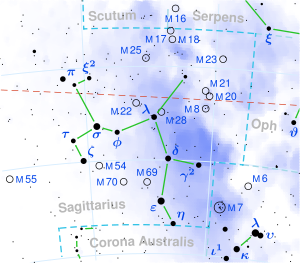9 Sagittarii
| Observation data Epoch J2000 Equinox J2000 | ||
|---|---|---|
| Constellation | Sagittarius | |
| Right ascension | 18h 03m 52.44501s[1] | |
| Declination | −24° 21′ 38.6323″[1] | |
| Apparent magnitude (V) | 5.97[2] | |
| Characteristics | ||
| Spectral type | O4V((f))z[3] (O3.5V((f+)) + O5–5.5V((f))[4]) | |
| U−B color index | −0.89[2] | |
| B−V color index | 0.00[2] | |
| Absolute magnitude (MV) | −6.20[4] | |
Semi-amplitude (K1)(primary) | 36+4 −1 km/s | |
| Semi-amplitude (K2) (secondary) | 49±3 km/s | |
| Details Myr | ||
| J18039-2422 | ||
| Database references | ||
| SIMBAD | data | |
9 Sagittarii (9 Sgr) is a massive binary star in the constellation Sagittarius. It has an apparent magnitude of 5.97. Both components are highly luminous O-type main-sequence stars.
Surroundings

9 Sgr is a naked eye star lying in the direction of the Lagoon Nebula (Messier 8), very close to the central condensation of the Hourglass Nebula around Herschel 36. It was not catalogued by Bayer with a Greek letter, but was listed by Flamsteed as number 9 in the constellation Sagittarius. It lies close to the open cluster NGC 6530. 9 Sgr is the main source of ionisation for much of the visible nebulosity in the region, although the young O star Herschel 36 ionises the dense Hourglass Nebula region.[8]
9 Sgr itself is surrounded by an ionised
The distances to 9 Sgr, M8, and NGC 6530 are uncertain, but generally estimated to be between 1,200 and 1,800 parsecs. Recent studies derive a distance around 1,250 pc for the M8 region.[8] Erosion of the front of the molecular cloud apparently caused by 9 Sgr suggests that it lies in front of the cloud, but studies of 9 Sgr as a binary star give a distance of 1,790 pc.[4][9] A 2021 study of the binary system derives a distance of 1,310±60 pc. On this basis, it is thought to be a member of the NGC 6530 open cluster.[6]
System
9 Sagittarii is a binary system with the longest known period for a pair of class O stars at 9.1 years. The orbit is eccentric and the separation between the stars varies from 11 AU to 27 AU. The large separation means that the stellar winds of the two stars do not impact strongly and so the pair are not a strong source of x-rays. Lack of x-rays, low orbital velocities, and similar spectral types merging to a combined spectrum of O4V, mean that 9 Sgr was only confirmed to be a binary in 2012.[4] Earlier clues such as nonthermal radio emission and periodic spectral line profile variations had prompted the detail search for a companion.[10][11]
The two stars have been resolved using the
Properties
Both components of 9 Sgr are massive
References
- ^ S2CID 244398875. Gaia DR3 record for this source at VizieR.
- ^ Bibcode:2002yCat.2237....0D.
- S2CID 118847528.
- ^ S2CID 19967446.
- S2CID 119231169.
- ^ S2CID 235125785.
- S2CID 119120927.
- ^ Bibcode:2008hsf2.book..533T.
- S2CID 55429395.
- doi:10.1086/162040.
- .
- S2CID 58911264.
- S2CID 53500788.

